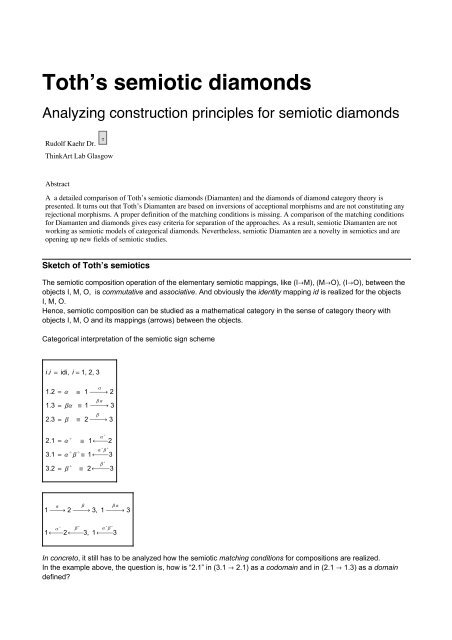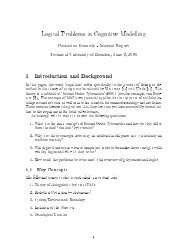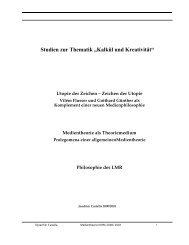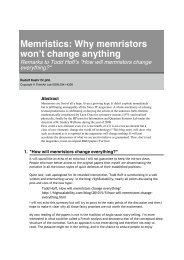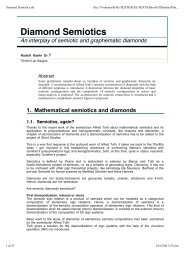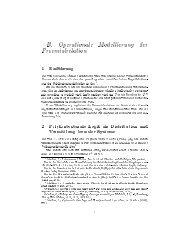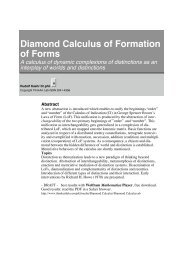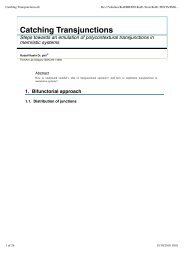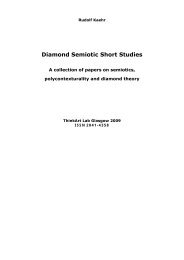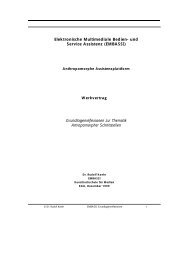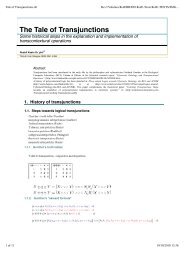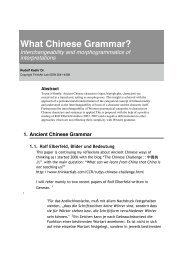Toth's semiotic diamonds - ThinkArt Lab!
Toth's semiotic diamonds - ThinkArt Lab!
Toth's semiotic diamonds - ThinkArt Lab!
You also want an ePaper? Increase the reach of your titles
YUMPU automatically turns print PDFs into web optimized ePapers that Google loves.
Toth’s <strong>semiotic</strong> <strong>diamonds</strong><br />
Analyzing construction principles for <strong>semiotic</strong> <strong>diamonds</strong><br />
Rudolf Kaehr Dr.<br />
<strong>ThinkArt</strong> <strong>Lab</strong> Glasgow<br />
„ «<br />
Abstract<br />
A a detailed comparison of Toth’s <strong>semiotic</strong> <strong>diamonds</strong> (Diamanten) and the <strong>diamonds</strong> of diamond category theory is<br />
presented. It turns out that Toth’s Diamanten are based on inversions of acceptional morphisms and are not constituting any<br />
rejectional morphisms. A proper definition of the matching conditions is missing. A comparison of the matching conditions<br />
for Diamanten and <strong>diamonds</strong> gives easy criteria for separation of the approaches. As a result, <strong>semiotic</strong> Diamanten are not<br />
working as <strong>semiotic</strong> models of categorical <strong>diamonds</strong>. Nevertheless, <strong>semiotic</strong> Diamanten are a novelty in <strong>semiotic</strong>s and are<br />
opening up new fields of <strong>semiotic</strong> studies.<br />
Sketch of Toth’s <strong>semiotic</strong>s<br />
The <strong>semiotic</strong> composition operation of the elementary <strong>semiotic</strong> mappings, like (IØM), (MØO), (IØO), between the<br />
objects I, M, O, is commutative and associative. And obviously the identity mapping id is realized for the objects<br />
I, M, O.<br />
Hence, <strong>semiotic</strong> composition can be studied as a mathematical category in the sense of category theory with<br />
objects I, M, O and its mappings (arrows) between the objects.<br />
Categorical interpretation of the <strong>semiotic</strong> sign scheme<br />
i.i = idi, i = 1, 2, 3<br />
1.2 = a ª 1<br />
1.3 = ba ª 1<br />
2.3 = b ª 2<br />
a<br />
b a<br />
b<br />
2<br />
3<br />
3<br />
2.1 = a Î ª 1<br />
a Î 2<br />
3.1 = a Î b Î ª 1 a Î b Î 3<br />
3.2 = b Î ª 2<br />
b Î 3<br />
1<br />
a<br />
2<br />
b<br />
3, 1<br />
b a<br />
3<br />
1<br />
a Î 2<br />
b Î 3, 1 a Î b Î 3<br />
In concreto, it still has to be analyzed how the <strong>semiotic</strong> matching conditions for compositions are realized.<br />
In the example above, the question is, how is “2.1” in (3.1 Ø 2.1) as a codomain and in (2.1 Ø 1.3) as a domain<br />
defined?<br />
The new question which arises for abstract diamond theory is: How are the difference relations and hence the<br />
hetero-morphisms defined in concreto?<br />
I had the idea that the papers of Toth are filling this gap with his <strong>semiotic</strong> modeling of <strong>diamonds</strong>. But it turned out<br />
that there is a cricial difference between ‘semiotische Diamanten” and categorical <strong>diamonds</strong>.
2 <strong>Toth's</strong> Semiotics.nb<br />
In concreto, it still has to be analyzed how the <strong>semiotic</strong> matching conditions for compositions are realized.<br />
In the example above, the question is, how is “2.1” in (3.1 Ø 2.1) as a codomain and in (2.1 Ø 1.3) as a domain<br />
defined?<br />
The new question which arises for abstract diamond theory is: How are the difference relations and hence the<br />
hetero-morphisms defined in concreto?<br />
I had the idea that the papers of Toth are filling this gap with his <strong>semiotic</strong> modeling of <strong>diamonds</strong>. But it turned out<br />
that there is a cricial difference between ‘semiotische Diamanten” and categorical <strong>diamonds</strong>.<br />
Therefore, there is still an open question about a <strong>semiotic</strong> concretization of categorical <strong>diamonds</strong>.<br />
Toth is suggesting an answer to the question, how to interpret the difference relations, with the introduction of the<br />
operation of inversion INV of a concrete sign scheme. Hence, Toth’s interpretation of <strong>diamonds</strong> tries to join<br />
together <strong>semiotic</strong> and diamond thematizations and notational systems.<br />
Inversion<br />
Where is this operation INV from?<br />
The sign relation ZR is defined as a relation of monadic, dyadic and triadic relations:<br />
ZR = (a, (aïb), (aïbïc).<br />
Sign values for ZR are:<br />
a = {1.1, 1.2, 1.3}<br />
b = {2.1, 2.2, 2.3}<br />
c = {3.1, 3.2, 3.3}<br />
ZR = with x,y,zœ{1,2,3} and x§y§z.<br />
It is clear, that the <strong>semiotic</strong> inversion operation INV is a <strong>semiotic</strong> operation based on the elementary operations of<br />
transpositions and is not leading out of the <strong>semiotic</strong> domain.<br />
INV is defined by:<br />
INV(a.b c.d e.f) = (e.f c.d a.b).<br />
In contrast, dualization is defined as:<br />
DUAL(a.b c.d e.f) = (f.e d.c b.a).<br />
The abstract sign scheme gets an interpretation by the introduction of the instances:<br />
I = interpretant, M=medium and O=object.<br />
Hence, the <strong>semiotic</strong> triad occurs as morphisms between the instances I, O, M and their combinations, called<br />
graph theoretic sign models.<br />
1. (IöO öM) 4. (OöMöI)<br />
2. (MöOöI) 5. (IöMöO), (MöIöO)<br />
3. (IöMö O) 6. (OöIöM).<br />
It is proposed by the Stuttgarter School of <strong>semiotic</strong>s (Bense, Walter) that those triadic sign schemes can be<br />
composed by their dyadic relations (mappings).<br />
Most of the <strong>semiotic</strong> work is in German, thus it is easily possible that I will miss the correct terminology.<br />
Example:<br />
2. (M ï O) (O ï I) = (M ï O • Oï I)<br />
Hence, triadic-trichotomic sign relations are compositions of dyadic-dichotomic relations. This is a strong thesis,<br />
and I don’t see the necessity of such a reduction.<br />
Even more problematic, Elisabeth Walter (1979, S. 79), speaks of a lattice theoretical union of “(M ï O) (O ï I)<br />
= (M ï O.Oï I)". (Toth, (2008b), p.11)<br />
Bense (1976) is mentioning a category theoretical composition of the triadic sign conceived as a transition from<br />
the set theoretic and relational definition to a more adequate presentation (Darstellung) of <strong>semiotic</strong>ity .<br />
In the following, I will first follow this strategy, then I will focus on the composition of triadic-trichotomic sign<br />
structures as such.<br />
The diamondization of the internal relations of signs might be called micro-analysis, the focus on the latter macro-
2. (M ï O) (O ï I) = (M ï O • Oï I)<br />
Hence, triadic-trichotomic sign relations are compositions of dyadic-dichotomic relations. This is a strong thesis,<br />
and I don’t see the necessity of such a reduction.<br />
Even more problematic, Elisabeth Walter (1979, S. 79), speaks of a lattice theoretical union of “(M ï O) (O ï I)<br />
= (M ï O.Oï I)". (Toth, (2008b), p.11)<br />
Bense (1976) is mentioning a category theoretical composition of the triadic sign conceived as a transition from<br />
the set theoretic and relational definition to a more adequate presentation (Darstellung) of <strong>semiotic</strong>ity .<br />
<strong>Toth's</strong> Semiotics.nb 3<br />
In the following, I will first follow this strategy, then I will focus on the composition of triadic-trichotomic sign<br />
structures as such.<br />
The diamondization of the internal relations of signs might be called micro-analysis, the focus on the latter macroanalysis<br />
of <strong>semiotic</strong> <strong>diamonds</strong>.<br />
These 6 graph theoretic sign models of I, O, M, get an interpretation by their corresponding numeric value<br />
occupancies.<br />
Example<br />
3.1 (IôOôM)<br />
(3.1 2.1 1.1) (3.1 2.3 1.3)<br />
(3.1 2.1 1.2) (3.2 2.2 1.2)<br />
(3.1 2.1 1.3) (3.2 2.2 1.3)<br />
(3.1 2.2 1.2) (3.2 2.3 1.3)<br />
(3.1 2.2 1.3) (3.3 2.3 1.3)<br />
(Thot, p. 2, 2008a)<br />
The new question which arises now is: How are the difference relations of the <strong>semiotic</strong> diamond and hence the<br />
hetero-morphisms defined in concreto? More precisely, how are the difference relations between the<br />
domains/codomains of morphisms and hetero-morphisms of <strong>semiotic</strong> composition defined? And is the inversion<br />
INV operation strong enough to define the differentness of the new hetero-morphisms?<br />
Response to Toth’s remark<br />
My question: “Is the inversion INV operation strong enough to define the differentness of the new heteromorphisms<br />
compared to morphisms?”<br />
Toth’s remark<br />
"In einer kürzlich veröffentlichten Kritik bemerkte Rudolf Kaehr zurecht, dass in dergestalt eingeführten<br />
semiotischen Diamanten die Heteromorphismen nichts anderes seien als Spiegelungen dyadischer semiotischer<br />
Funktionen (Kaehr 2008, S. 3).<br />
Kaehr übersieht allerdings, dass die Umkehrungen dyadischer Funktionen nur formal, aber nicht inhaltlich<br />
Spiegelungen sind. Z.B. bedeutet (2.1 fl 3.1) die rhematische Interpretation eines Abbildes, aber die umgekehrte<br />
Funktion (3.1 fl 2.1) muss, wie bereits Bense (1981, S. 124 ff.) bemerkte, nicht zum selben Icon zurückführen. Es<br />
kann sich hier also um einen echten semiotischen Heteromorphismus handeln.” [my emph]<br />
Response<br />
As far as I understand, Toth is pointing to the fact, that an inversion (Umkehrung, Spiegelung) of a morphism like<br />
(2.1 fl 3.1) is not re-establishing the identity of “2.1” in concreto.<br />
In other words, the formal inversion of a dyadic function is not identical with its mirroring with regard to its content.<br />
Hence, with an inversion INV (2.1 fl 3.1) = (3.1 fl 2.1), the role of “2.1” might change from a rhematic<br />
interpretation of an object to a different interpretation of an object, not necessary the same icon.<br />
The same is true for the inversion of morphisms in a category! But, nevertheless, category theory is studying<br />
morphisms and their inversions and duality in abstracto. The same is intended for diamond theory. Morphisms<br />
and heteromorphisms in <strong>diamonds</strong> are considered as abstract.<br />
That’s a reason too, while Toth’s approach to <strong>diamonds</strong> is important: he offers a concrete interpretation. Hence, it<br />
also could be understood as a model for abstract <strong>diamonds</strong>. On the other hand, <strong>diamonds</strong> are instrumental to<br />
solve some intriguing problems of mathematical <strong>semiotic</strong>s.<br />
With my introduction of <strong>diamonds</strong> and their hetero-morphisms I tried to distinguish them from both, inversions and<br />
duals (opposites) of morphisms. It is well known, that an inverted, also dual, morphism is still a morphism for<br />
which all the properties and laws for morphisms (identity, commutativity, associativity) of the category holds.<br />
While for hetero-morphisms, different laws are involved. And that’s the reason why they are called heteromorphism<br />
and are belonging to saltatories and not to categories.<br />
What I called antidromic direction of arrows for hetero-morphisms is not simply an inversion of the arrow of a<br />
morphism, and therefore still a morphism, but a new abstraction based on “difference” relations of the “targets”
That’s a reason too, while Toth’s approach to <strong>diamonds</strong> is important: he offers a concrete interpretation. Hence, it<br />
also could be understood as a model for abstract <strong>diamonds</strong>. On the other hand, <strong>diamonds</strong> are instrumental to<br />
solve some intriguing problems of mathematical <strong>semiotic</strong>s.<br />
4 <strong>Toth's</strong> Semiotics.nb<br />
With my introduction of <strong>diamonds</strong> and their hetero-morphisms I tried to distinguish them from both, inversions and<br />
duals (opposites) of morphisms. It is well known, that an inverted, also dual, morphism is still a morphism for<br />
which all the properties and laws for morphisms (identity, commutativity, associativity) of the category holds.<br />
While for hetero-morphisms, different laws are involved. And that’s the reason why they are called heteromorphism<br />
and are belonging to saltatories and not to categories.<br />
What I called antidromic direction of arrows for hetero-morphisms is not simply an inversion of the arrow of a<br />
morphism, and therefore still a morphism, but a new abstraction based on “difference” relations of the “targets”<br />
and “sources” of composed morphisms, i.e. of compositions. Hetero-morphisms are conceived as abstractions<br />
from the operation of composition and not from morphisms between objects. Even if those difference relations are<br />
considered as inversions, they have to take place at the right place, i.e. at the target of the first and at the domain<br />
of the second morphism of the composition of the morphisms.<br />
This in full harmony to what I developed from the very beginning of the introduction of the diamond concept<br />
(diamond category theory, diamond theory, etc.).<br />
The name “hetero-morphisms” might be misleading, but the formal definition is what counts and not its label.<br />
There is a different use of the term ‘hetero-morphism’ in my paper “Categories and Contextures”.<br />
Because <strong>diamonds</strong> are introduced in an abstract way, i.e. depending on the alpha/omega-structure of<br />
composition of morphisms only, it is of importance to find reasonable examples as concretizations. An other<br />
interesting concretization is the attempt to introduce diamond relations as a diamondization of relation theory.<br />
In this sense of concretization, I see the importance of Toth’s approach, albeit he is missing the train.<br />
Unfortunately, after I finally understood Toth’s concept “semiotischer Diamanten” (<strong>semiotic</strong> <strong>diamonds</strong>) it turned<br />
out that Toth’s “Diamanten” are strictly different from my ‘<strong>diamonds</strong>’.<br />
Hence, Toth has given some interesting interpretations for his “Diamanten” in the context of <strong>semiotic</strong>s but not to<br />
my <strong>diamonds</strong>. That is, my hope for a <strong>semiotic</strong> concretization of the abstract mathematical concept of ‘diamond<br />
category theory’ has still to wait to be achieved.<br />
Nevertheless, there are also creative misunderstandings! In this sense, both concepts, the “Diamanten” and the<br />
<strong>diamonds</strong>, are interesting topics. Toth’s “Diamanten” are, thus, a (creative) misinterpretation of my <strong>diamonds</strong>.<br />
Hence, despite the examples for ‘semiotische Diamanten’, the relevant question still is: How are <strong>semiotic</strong><br />
<strong>diamonds</strong> defined? Where are the properties, rules and laws? And, first of all, how are the difference relations<br />
introduced? There is surely an inversion operation in <strong>semiotic</strong>s but there is no abstraction corresponding to the<br />
diamond difference relations or operations.<br />
Semiotics is still depending on is-abstractions in contrast to as-abstractions in diamond theory.<br />
Diamonds, everywhere?<br />
Independent of the question of the motivation to mention that my teacher Gotthard Gunther had introduced<br />
<strong>diamonds</strong> long before my own humble trial, Toth’s move confirms clearly and without sophisticated manoeuvres<br />
of my interpretations what exactly he understands by a “Diamant" (diamond). Correctly, Toth understands by a<br />
Diamant the formal structure of a special square: Ì. Unfortunately, not all such <strong>diamonds</strong> are <strong>diamonds</strong> in the<br />
sense of the diamond category theory I introduced recently. What counts in a mathematical theory are the<br />
definitions, properties and rules. The same holds for diamond (category) theory.<br />
I’m quite convinced that my definitions, despite their tentativeness, are clear enough to show the difference<br />
between a ‘square’ concept and my diamond concept of an interplay between categorical and saltatorical arrows<br />
(maps, morphisms).<br />
In other words, <strong>diamonds</strong>, labeled with some mighty labels might seduce to engage into a recreational game but<br />
are by no way of any interest for my own work, which stands without any ‘didactical’ figures.<br />
The other hint to Toth’s diamond interpretation is given by his historical comments that I introduced myself the<br />
diamond approach first 1995 and then specially in 2007. I appreciate the honor I’ m given for a figure, which is<br />
known, at least outside polycontexturality, since tausends of years.<br />
In fact, I’m turning around in this carousel at least, officially, since 1973-75 (published 1978), with my closed<br />
proemial relationship ("geschlossene proemial Relation"), which Gunther liked very much, albeit I didn’t see much<br />
to formalize.
In other words, <strong>diamonds</strong>, labeled with some mighty labels might seduce to engage into a recreational game but<br />
are by no way of any interest for my own work, which stands without any ‘didactical’ figures.<br />
The other hint to Toth’s diamond interpretation is given by his historical comments that I introduced myself the<br />
diamond approach first 1995 and then specially in 2007. I appreciate the honor I’ m given for a figure, which is<br />
known, at least outside polycontexturality, since tausends of years.<br />
In fact, I’m turning around in this carousel at least, officially, since 1973-75 (published 1978), with my closed<br />
proemial relationship ("geschlossene proemial Relation"), which Gunther liked very much, albeit I didn’t see much<br />
to formalize.<br />
It was writen strategically against the Varela’s ECI and the re-entry mysticism.<br />
A university degree was achieved by my student Klaus Grochowiak with “Die formal Struktur der Zirkulation bei<br />
Karl Marx”, 1976, which is an intriguing application of <strong>diamonds</strong>, albeit labelled differently, and chiasms!<br />
Then, the very first diamond approach for communicational purposes (and money making) was developed 1992<br />
and was called, for a joke, “Das Existenz-Halma”. Halma is a board game. It worked! Why not? And again, I<br />
started a series of serious work about “Diamond Strategien" (1995-1998).<br />
Without doubt, I’m very much aware about that, i.e. my own intellectual history. Too long to tell! It would be<br />
surprisingly strange or even highly cranky if I would have proclaimed 2007 that I discovered the diamond of<br />
category theory or diamond category theory, not knowing that I and especially Gunther introduced <strong>diamonds</strong> long<br />
before.<br />
Again, the whole story is documented in my “Handbuch” (1995)! I simply would like to recall Daniel Hellerstein’s<br />
Diamond Logic! Which nevertheless has nothing to do with diamond theory.<br />
As often, misunderstandings might create some interesting results.<br />
But scholasticism of some groups is forcing me to offer some clarifications.<br />
<strong>Toth's</strong> Semiotics.nb 5<br />
Nevertheless, it is a merit of Alfred Toth to have done interesting work on the base of his concept of Diamanten<br />
and he has mentioned his source of inspiration as far as he has access to it.<br />
On the other hand, I feel motivated to typset even more constructions.<br />
Alfred Toth, Phantasie und Technik, 1.1.2009<br />
"Offiziell wurde der Diamant als logisches Modell erst durch Kaehr (1995) und vor allem Kaehr (2007) in die<br />
Polykontexturalitätstheorie eingeführt. Allerdings findet man bereits in Günthers “Bewusstsein der Maschinen”<br />
einen höchst interessanten Diamanten im Zusammenhang mit der reflexionstheoretischen Begründung einer<br />
Theorie des Willens im Sinne einer Theorie transzendentaler Handlungen:
6 <strong>Toth's</strong> Semiotics.nb<br />
Toth’s general procedure<br />
"Die semiotische Rejektionsfunktion ist nun aber keineswegs auf den Strukturtyp (e.f c.d a.b) wie im obigen<br />
semiotischen Diamanten beschränkt. Semiotische Inversion (INV) ist allgemein durch folgende zwei<br />
Anweisungsschritte erreichbar:<br />
1. Kehre die Reihenfolge der konstituierenden Subzeichen einer Zeichenklasse (oder einer ihrer Transpositionen<br />
bzw. Dualisationen) um.<br />
2. Vertausche alle semiotischen Morphismen mit ihren Inversen (wobei natürlich z.B. a°°= a, b°° = b und per<br />
definitionem (vgl. Toth 1993, S. 21 ff.) (ba)° = a°b° und (a°b°)°= ba gilt.”<br />
INV - Rules<br />
I. a±± = a, b±± = b,<br />
II. HbaL ± = a±b±,<br />
III. id± = id<br />
Ha±b±L ± = Hb±± a± ± L = ba HIV.L<br />
Hence, there are two steps to consider for the construction of a hetero-morphism in a <strong>semiotic</strong> diamond:<br />
1. Chiasm: Change the order of subsigns.<br />
2. Inversion: Exchange all <strong>semiotic</strong> morphisms with their inversion.<br />
This can be reformulated by:<br />
1. Apply the inverse operation INV to the parts (A 3 , B 3 ) of an (acceptional) morphism (morph 3 L .<br />
An acceptional morphism is the composition of two basic morphism of a <strong>semiotic</strong> category.<br />
2. Substitute the results of the first part, (A 3 L, of the morphism with the second part, (B 4 ), of the heteromorphism,<br />
morph 4 , to be constructed. And the same procedure with the second part, (B 3 L; substitute it with the<br />
first part (A 4 L of the hetero-morphism morph 4 .<br />
And additionally:<br />
3. Positioning, difference, matching conditions<br />
3.1 The second part of the first morphism, its codomain or target, and the first part of the hetero-morphism, its<br />
domain, source, have to be matched.<br />
3.2 The first part of the second morphism, its domain or source, and the second part of the hetro-morphism, its<br />
codomain, target, have to be matched.<br />
A hetero-morphism is the rejectional morphism of an acceptional morphism. But this distinction has first to be<br />
established. Without the distinction between acceptional and rejectional morphism, the constructed heteromorphism<br />
is not yet placed. To realize its correct placement, a new condition has to be fulfilled. It is the role of the<br />
difference relations to organize such a placement of a not yet positioned hetero-morphism.<br />
It seems that Toth’s approach is not considering this part of the construction.<br />
Semiotic hetero - morphism construction<br />
" morph HA 3 , B 3 L, HA 4, B 4 L œ SEMIOTICS<br />
IF<br />
HA 3 , B 3 L œ Morph<br />
Subst<br />
IINVIA 3 MëB 4 MÔ Subst<br />
IINVIB 3 MëA 4 M<br />
THEN<br />
HA 4, B 4 L œ Het - M orph.<br />
Schemes of inversion and exchange<br />
aL intended scheme?<br />
C ô A : heter<br />
» ? » ?<br />
HA B L o HB öC L : comp<br />
…<br />
…<br />
A C : morph
<strong>Toth's</strong> Semiotics.nb 7<br />
aL intended scheme?<br />
C ô A : heter<br />
» ? » ?<br />
HA B L o HB öC L : comp<br />
…<br />
…<br />
A C : morph<br />
bL realised scheme!<br />
A : heter<br />
» »<br />
_<br />
HA B L o HB öC L : comp<br />
C _<br />
…<br />
A C : morph<br />
…<br />
Example<br />
A 3 = Aa Î b Î , aE ö @id1, bD = B 3<br />
INV, Subst<br />
B 4 = A ba, a Î E ô Aid1, b Î E = A 4<br />
AAid1, b Î E, A ba, a Î EE = heter 4<br />
x<br />
AAa Î b Î , aE, @id1, bDE = morph 3<br />
Toth’s examples are showing a solution in the sense of scheme (a), i.e. a hetero-morphism (heter 4 L is defined as<br />
a direct inversion of an acceptional morphism (morph 3 L. And morph 3 is a composition of<br />
morph 1 and morph 2 .<br />
Inversion (categorical dualisation)<br />
It seems that the first step of ‘chiastic exchange’ is included in the definition of the inversion operation.<br />
Example<br />
1. Chiastic exchange H" external exchange "L<br />
A 3 = Aa Î b Î , aE ö @id1, bD = B 3<br />
INV IA 3 öB 3 M = INV IB 3 Mô INV IA 3 M. This is the ' exchange' H by INV - RuleI - IIL<br />
= INV IA 3 Mò INV IB 3 M<br />
2. Inversions H" internal exchange "M<br />
A 3 = Aa Î b Î , aE = I Aa Î bE ö aM<br />
B 3 = @id1, bD = Hid1 ö bL<br />
INV IA 3 M = INV I Aa Î bE ö aM :<br />
= IINV HaLöIINV I Aa Î b Î EMM : INV - RuleI - II<br />
= Ia Î ö @abDM = A 4<br />
INV IB 3 M = INV Hid1 ö bL<br />
= IINV HbLö INV Hid1L : INV - RuleI - II<br />
= Ib Î ö id1M = B 4 •<br />
Toth’s notation for brackets [x, y] in [x, y], [z]] of a hetero-morphism could mislead to a wrong interpretation if<br />
taken as a mapping "(x)ö (y), but [x, y] is by definition, in this setting, a non-decomposable “object".<br />
Further comparisons: Are Diamanten <strong>diamonds</strong>?<br />
Hence, the difference to my approach is clear. Hetero-morphisms are not directly accessible by acceptional<br />
morphisms but are depending on the structure of the composition of morphisms. That is, the process of<br />
composition is reflected in hetero-morphisms, while acceptional morphisms are the positive or direct results of<br />
compositions, i.e. morph 1 o morph 2 = morph 3 .
8 <strong>Toth's</strong> Semiotics.nb<br />
Further comparisons: Are Diamanten <strong>diamonds</strong>?<br />
Hence, the difference to my approach is clear. Hetero-morphisms are not directly accessible by acceptional<br />
morphisms but are depending on the structure of the composition of morphisms. That is, the process of<br />
composition is reflected in hetero-morphisms, while acceptional morphisms are the positive or direct results of<br />
compositions, i.e. morph 1 o morph 2 = morph 3 .<br />
A consequence of Toth’s approach seems to be the lack of jumping situation or saltisitions for general Diamanten.<br />
Toth’s hetero-morphisms are connected and composed without any gaps to be over-jumped and hence, the<br />
associativity rule holds unrestrictedly.<br />
The main difficulty to understand properly Toth’s approach has two reasons:<br />
1. the diagrams used are not always clear. Different readings are possible, because<br />
2. there are no formal matching conditions (MC) for compositions of morphisms and hetero-morphisms defined.<br />
Diagr.I a : Associativity morph , morph for Diamanten<br />
w 9<br />
w 4<br />
m<br />
k<br />
w 8<br />
a 4<br />
l<br />
a 9<br />
a 8<br />
B<br />
a 1 ö f w 1 © a 2 ö g w 2 © a 5 ö h w 5 F<br />
fg<br />
a 3<br />
w 3<br />
gh<br />
a 6<br />
w 6<br />
fgh<br />
a 7<br />
w 7<br />
Diamanten MC<br />
a 1 ª a 3 ª a 7 ª w 4 ª w 9<br />
w 2 ª w 3 ª a 4<br />
a 2 ª a 6 ª w 8<br />
w 5 ª w 6 ª w 7 ª a 8 ª a 9<br />
Diagr. Ib : Diamanten, collected Inversa<br />
D<br />
A<br />
A<br />
D<br />
D<br />
B<br />
B<br />
D<br />
C<br />
A<br />
A<br />
C<br />
HA<br />
B L o HB öC L o HC öDL
<strong>Toth's</strong> Semiotics.nb 9<br />
Diagr.II : Ass for morph, jump for het for <strong>diamonds</strong><br />
w 9<br />
m =k ° l<br />
a 9<br />
w 4 k a 4 w 8 l a 8<br />
B<br />
a 1 ö f w 1 ©a 2 ö g w 2 © a 5 ö h w 5<br />
F<br />
a 3<br />
fg<br />
w 3<br />
gh<br />
a 6<br />
w 6<br />
fgh<br />
a 7<br />
w 7<br />
Diamond MC<br />
a 1 ª a 3 ª a 7,<br />
a 2 ª a 4 ª a 6<br />
a 5 ª a 8 ª a 9,<br />
w 1 ª w 4 ª w 9 ,<br />
w 2 ª w 3 ª w 8 ,<br />
w 5 ª w 6 ª w 7 .<br />
Again, because diagrams are not telling much without their formal definitions, I repeated the formal definitions of<br />
the diagrams for Diamanten and for <strong>diamonds</strong>.<br />
And, unfortunately, programs are still not stable enough to produce proper results in different formats.<br />
The above diagram is <strong>semiotic</strong>ally concretised by Toth’s example for a <strong>semiotic</strong> Diamant based on 3 composed<br />
<strong>semiotic</strong> morphisms.<br />
As a first result we might observe that Toth’s hetero-morphisms are a kind of counter-morphisms. They might<br />
even have the properties of being: “... genuinely tetradic, chiastic, antidromic and 4-fold.” And they are connected<br />
with morphisms by inversion and chiastic exchange. Obviously those properties are necessary but maybe not<br />
sufficient for <strong>diamonds</strong>.<br />
What I proposed as <strong>diamonds</strong> at different places, are structures with very different laws compared to the laws of<br />
categories. That is, <strong>diamonds</strong>, which consist of a complementary interplay of categories and saltatories, are as<br />
categorical systems identitive, commutative and associative in respect to their objects, morphisms and<br />
composition. Therefore, inheriting all the laws and methods from category theory. In sharp contrast, saltatories as<br />
parts of <strong>diamonds</strong>, are ruled by difference, jumps (saltisitions) and jump-associativity, etc.<br />
Additionally, <strong>diamonds</strong> as such, are containing bridges and bridging rules between categories and saltatories.
10 <strong>Toth's</strong> Semiotics.nb<br />
„ Again, diamond definitions<br />
Diamond composition rule HM a Ø O w L © HO a Ø I w L<br />
è è<br />
HM a Ø I w L ° IO w ô O aM<br />
è<br />
O a ª diffHO a L<br />
è<br />
ª diffHO w L.<br />
O w<br />
Diagram of diamond composition<br />
è<br />
KO w<br />
ô het 4<br />
è<br />
O aO<br />
diff ê<br />
î diff<br />
KM a<br />
morph 1 Ow O © KO a<br />
morph 2 Iw O<br />
î id<br />
ê id<br />
M a<br />
morph 3<br />
I w<br />
Diagram of diamond composition<br />
with matching conditions MC<br />
w 1 Πf , a 2 Πg :<br />
dHa 2 L = a 4 Ô d Hw 1 L = w 4 . fi . w 4 ¨k a 4<br />
w 4 k a 4<br />
ò ò<br />
B<br />
a 1 Ø w 1 © a 2 Ø w 2<br />
f g F a 1 ª a 3 ,<br />
î<br />
ê a 2 ª a 4 ,<br />
w<br />
a 3 w 1 ª w 4 ,<br />
3<br />
fg<br />
w 2 ª w 3 .<br />
One of Toth’s <strong>semiotic</strong> motivations for <strong>diamonds</strong><br />
"Ein sowohl für die Semiotik wie für die Kybernetik wichtiges Ergebnis ist, dass zwar die Abbildung von<br />
Zeichenklassen auf Morphismen eindeutig ist, nicht aber die Abbildung von Morphismen auf<br />
Realitätsthematiken: Während also a° ö (2.1), id2 ö (2.2), bö (2.3) gilt, erhalten wir für ((2.1), (2.1)),<br />
((2.2), (2.2), (2.2)) und ((2.3), (2.3)) jedesmal id2, d.h. bei den Semiosen zwischen Trichotomischen Triaden,<br />
die ja aus Realitätsthematiken konstruiert sind, können die für Zeichenklassen eingeführten Morphismen nicht<br />
zwischen den trichotomischen Stellenwerten unterscheiden!<br />
Der Grund dafür hängt wohl mit der Tatsache zusammen, dass dynamische (generative) Semiosen und<br />
(degenerative) Retrosemiosen im Gegensatz statischen Subzeichen und Zkln/Rthn nicht umkehrbar-eindeutig<br />
sind, weshalb in Toth (2008a) der Versuch unternommen wurde, sie mit Rudolf Kaehrs Hetero-Morphismen<br />
im Rahmen seiner polykontexturalen Diamanten-Theorie zu identifizieren (vgl. Kaehr 2007).<br />
Sollte diese Identifikation statthaft sein, kommt denjenigen Trichotomischen Triaden, die wie etwa die Nrn.<br />
589 und 617 ausschliesslich aus semiotischen Heteromorphismen (und idx) und vor allem denjenigen, die<br />
(neben) idx nur Morphismen und ihre korrespondierenden Heteromorphismen enthalten wie etwa den Nrn.<br />
551, 561 und 564, besondere Bedeutung im Zusammenhang mit einer erst zu entwickelnden kybernetischen<br />
Semiotik der 2. Ordnung bzw. einer Vereinigung von Semiotik und Polykontexturalitätstheorie zu.” (Toth,<br />
Kybernetik, p.663/64)<br />
589 @II, OO, MMD ó @3.1 µ 3.2 µ 3.3 | 2.1 µ 2.2 µ 2.3 | 1.1 µ 1.2 µ 1.3D<br />
ó @aºbº bº id3 | aº id2 b | id1 a baD<br />
3.1 µ 3.2 µ 3.3 2.1 µ 2.2 µ 2.3 3.1 µ 3.2 µ 3.3<br />
T1 : 2.1 µ 2.2 µ 2.3 T2 : 1.1 µ 1.2 µ 1.3 T3 : 1.1 µ 1.2 µ 1.3
Sollte diese Identifikation statthaft sein, kommt denjenigen Trichotomischen Triaden, die wie etwa die Nrn.<br />
589 und 617 ausschliesslich aus semiotischen Heteromorphismen (und idx) und vor allem denjenigen, die<br />
(neben) idx nur Morphismen und ihre korrespondierenden Heteromorphismen enthalten <strong>Toth's</strong> wie etwa Semiotics.nb den Nrn. 11<br />
551, 561 und 564, besondere Bedeutung im Zusammenhang mit einer erst zu entwickelnden kybernetischen<br />
Semiotik der 2. Ordnung bzw. einer Vereinigung von Semiotik und Polykontexturalitätstheorie zu.” (Toth,<br />
Kybernetik, p.663/64)<br />
589 @II, OO, MMD ó @3.1 µ 3.2 µ 3.3 | 2.1 µ 2.2 µ 2.3 | 1.1 µ 1.2 µ 1.3D<br />
ó @aºbº bº id3 | aº id2 b | id1 a baD<br />
3.1 µ 3.2 µ 3.3 2.1 µ 2.2 µ 2.3 3.1 µ 3.2 µ 3.3<br />
T1 : 2.1 µ 2.2 µ 2.3 T2 : 1.1 µ 1.2 µ 1.3 T3 : 1.1 µ 1.2 µ 1.3<br />
b' 1 = @ b±, b±, b±D b' 2 : = @a±, a±, a±D b' 3 = @a±b±, a±b±, a±b±D<br />
›b' i = « Hp .595L<br />
Playing the game<br />
Now I would like to test Toth’s construction rules (INV, exchange) in reconstructing his examples.<br />
It seems, that the INV rule is always working if applied in the introduced sense as “INV = inv(inv, inv)" . With the<br />
help of the exchange advise, INV is reduced to "(inv, inv)".<br />
Again, Toth’s example and an explicite notation:<br />
Aa, a º b º E @b, id 1 D : morph 4<br />
ë ï<br />
A b º , id 1 E © Aa º , baE<br />
ï ë<br />
A b º , id 1 E ö Aa º , baE : morph 3<br />
explicite notation<br />
Aa Ia º b º ME @b id 1 D : morph 4<br />
ë ï<br />
A b º Ø id 1 E © Aa º Ø baE : morph 1 o morph 2<br />
ï<br />
ë<br />
A b º Ø id 1 E ö Aa º Ø H baLE : morph 3<br />
„ Example1<br />
H1.3 µ 1.2 µ 3.1L<br />
AAid1, b Î E, @ba, a Î DE<br />
Aa Î b Î , aE o @id1, bD<br />
AAa Î b Î , aE, @id1, bDE<br />
H3.1 µ 1.2 µ 1.3L<br />
1. A 3 = @a Î b Î , aD ï A 4 = @ba, a Î D = @ba a Î D<br />
2. B 3 = @id1, bD ï B 4 = @id1, b Î D = @id1 b Î D<br />
INVERSION INV<br />
ad1. INV H@a Î b Î , aDL = INV H@INV H@a Î b Î DL, INV H@aDL<br />
= @INV H@aDL, INV H@a Î b Î DL
12 <strong>Toth's</strong> Semiotics.nb<br />
1. A 3 = @a Î b Î , aD ï A 4 = @ba, a Î D = @ba a Î D<br />
2. B 3 = @id1, bD ï B 4 = @id1, b Î D = @id1 b Î D<br />
INVERSION INV<br />
ad1. INV H@a Î b Î , aDL = INV H@INV H@a Î b Î DL, INV H@aDL<br />
= @INV H@aDL, INV H@a Î b Î DL<br />
= @@a Î D, @baDD = @a Î , baD = @a Î öbaD = A 4<br />
ad2. INV H@id1, bDL<br />
= INV H@INV Hid1L, INV HbLDL<br />
= @INV HbL, INV Hid1LD<br />
= @b Î , id1D = @b Î ö id1D = B 4<br />
„ Example2<br />
H3.1 µ 2.1 µ 1.3L<br />
AAb Î , id1E, @a Î , baDE<br />
Aa, a Î b Î E o @b, id1D<br />
AAa, a Î b Î E, @b, id1DE<br />
H1.3 µ 2.1 µ 3.1L<br />
1. A 3 = @a, a Î b Î D ï A 4 = @a Î , baD = @a Î baD<br />
2. B 3 = @b, id1D ï B 4 = @b Î , id1D = @b Î id1D<br />
INVERSION INV<br />
ad1. INV@a, a Î b Î D = @a Î , baD<br />
= INV HINV@aD, INV@ a Î b Î DL<br />
= INV@a Î b Î D, INV@aD<br />
= @@baD, a Î D = @ba, a Î D = @baöa Î D = A 4<br />
ad2. INV@b, id1D<br />
= @b Î , id1D<br />
= INV@INV HbL Ø INV Hid1LD<br />
= @INV Hid1L Ø INV HbLD<br />
= @id1 Ø b Î D = B 4<br />
Are Toth’s hetero-morphism and <strong>semiotic</strong> <strong>diamonds</strong> the same constructs or constructs in the same spirit as the diamond<br />
categories introduced by my own intuitions? What could the difference be? And how could such a possible difference<br />
matter?<br />
Toth’s construction is considering the complementarity between acceptional and rejectional morphisms based on inversion<br />
(INV) and chiastic exchange.<br />
This corresponds to some sketches I produced myself. But I conceived them as abbreviations of the difference based<br />
constructions.<br />
"Compositions as well as sautisitions (jump-operations) are ruled by identity and associativity laws. Complementarity<br />
between categories and saltatories, i.e., between acceptional and rejectional domains of <strong>diamonds</strong>, are ruled by difference<br />
operations.” (Kaehr, p.3)
<strong>Toth's</strong> Semiotics.nb 13<br />
„ Comparision: Toth’s Diamanten and <strong>diamonds</strong><br />
The following definitions could give a hint to understand the difference between the two diamond<br />
constructions.<br />
Complementarity of Acc and Rej based on diff<br />
X œ Acc iff complHXL œ Rej<br />
X = g o f :<br />
1. X œ Acc if complHXL œ R e j<br />
complHg o fL<br />
Hu : w 4 a 4 L œ Rej<br />
= compl HcomplHgL o complHfLL<br />
= complHdiffHcodHfLL o diffHdomHgLLL<br />
= complJJB c<br />
¯ o d N o JB d<br />
¯ o m NN = w 4 a 4 .<br />
Hence, Hg o fL œ Acc if Hu : w 4 a 4 L œ Rej<br />
Hg o fL œ Acc if Jg ¯o fN œ Rej.<br />
2. complHXL œ Rej if X œ Acc<br />
complHw 4 a 4 L = complHcomplHw 4 L complHa 4 LL<br />
= complHHA d o m Ø B c o d L HB d o m Ø C c o d LL<br />
= HHA d o m Ø B c o d L o HB d o m Ø C c o d LL<br />
= Hf o gL.<br />
3. Hence, X œ Acc iff complHXL œ Rej.<br />
In this "proof", the complementarity operation "compl" is used quite freely to do also the transitional job of<br />
completing the morphisms out of the objects. This is done by the operation of "difference" and "completition",<br />
which is completing domains and codomains to their morphisms. This points to the asymmetry of Acc- and Rejdomains.<br />
Toth’s complementarity operation between acceptional and rejectional morphisms, played by INV and exchange,<br />
is symmetrical.<br />
The open question for the construction of <strong>semiotic</strong> <strong>diamonds</strong> still is: How is the difference relation defined,<br />
concretely?<br />
Again, Toth’s approach, despite its own merits, is not answering this questions, simply because they don’t exist<br />
for his Diamanten.<br />
„ Similarity?<br />
The nearest comparision between Toth’s approach to diamond and what I published myself can be found in the<br />
general complementarity between acceptional and rejectional morphisms as sketched below. Nevertheless, the<br />
definitions of the hetero-morphisms k, l, m are based on the abstractions of compositions and not on objects. That<br />
is, hetero-morphism k : d(a 2 ) = a 4 and d(w 1 L = w 4 .ETC!<br />
w 1 œ f , a 2 œ g :<br />
dHa 2 L = a 4 Ô d Hw 1 L = w 4 . fl . w 4 k a 4<br />
w 9<br />
m<br />
a 9<br />
w 4 k a 4 w 8 l a 8<br />
B<br />
a 1 ö f w 1 ëa 2 ö g w 2 ë a 5 ö h w 5<br />
F<br />
a 3<br />
fg<br />
w 3<br />
gh<br />
a 6<br />
w 6<br />
fgh<br />
a 7<br />
w 7<br />
Diamond MC<br />
a 1 ª a 3 ª a 7,<br />
a 2 ª a 4 ª a 6<br />
a 5 ª a 8 ª a 9,<br />
w 1 ª w 4 ª w 9 ,<br />
w 2 ª w 3 ª w 8 ,<br />
w 5 ª w 6 ª w 7 .
14 <strong>Toth's</strong> Semiotics.nb<br />
w 1 œ f , a 2 œ g :<br />
dHa 2 L = a 4 Ô d Hw 1 L = w 4 . fl . w 4 k a 4<br />
w 9<br />
m<br />
a 9<br />
w 4 k a 4 w 8 l a 8<br />
B<br />
a 1 ö f w 1 ëa 2 ö g w 2 ë a 5 ö h w 5<br />
F<br />
a 3<br />
fg<br />
w 3<br />
gh<br />
a 6<br />
w 6<br />
fgh<br />
a 7<br />
w 7<br />
Diamond MC<br />
a 1 ª a 3 ª a 7,<br />
a 2 ª a 4 ª a 6<br />
a 5 ª a 8 ª a 9,<br />
w 1 ª w 4 ª w 9 ,<br />
w 2 ª w 3 ª w 8 ,<br />
w 5 ª w 6 ª w 7 .<br />
complementarity of accept, reject<br />
rejectHfgL = k iff acceptHkL = HfgL<br />
rejectHghL = l iff acceptHlL = HghL<br />
rejectHfghL = m iff acceptHmL = HfghL<br />
Thus, the operation reject(gf) of the composition of the acceptance morphisms f and g is producing the rejectance<br />
hetero-morphism k.<br />
And the operation accept(k) of the rejectance morphism k is producing the acceptance of the composition of the<br />
morphisms g and f.<br />
Comparision of Diamanten and <strong>diamonds</strong><br />
Diamond MC H3L<br />
a 1 ª a 3 ,<br />
a 2 ª a 4 ,<br />
w 1 ª w 4 ,<br />
w 2 ª w 3 .<br />
Diamant MC H3L<br />
a 1 ª a 3 ª w 4<br />
w 2 ª w 3 ª a 4<br />
plus MC for compositions
<strong>Toth's</strong> Semiotics.nb 15<br />
Diamond MC H4L<br />
a 1 ª a 3 ª a 7,<br />
a 2 ª a 4 ª a 6<br />
a 5 ª a 8 ª a 9,<br />
w 1 ª w 4 ª w 9 ,<br />
w 2 ª w 3 ª w 8 ,<br />
w 5 ª w 6 ª w 7 .<br />
Diamant MC H4L<br />
a 1 ª a 3 ª a 7 ª w 4 ª w 9<br />
w 2 ª w 3 ª a 4<br />
a 2 ª a 6 ª w 8<br />
w 5 ª w 6 ª w 7 ª a 8 ª a 9<br />
That is,<br />
" MC :<br />
MC diamond ≠ MC Diamant<br />
î<br />
Diamanten ≠ <strong>diamonds</strong><br />
This detailed comparison of Toth’s <strong>semiotic</strong> <strong>diamonds</strong> (Diamanten) and the <strong>diamonds</strong> of diamond category<br />
theory has shown some results:<br />
| Toth’s Diamanten are based on inversions of acceptional morphisms and are not constituting any rejectional<br />
morphisms.<br />
| A proper definition of the matching conditions is missing.<br />
| A comparison of the matching conditions for Diamanten and <strong>diamonds</strong> gives easy criteria for separation of<br />
both approaches.<br />
| As a result, <strong>semiotic</strong> Diamanten are not working as <strong>semiotic</strong> models of categorical <strong>diamonds</strong>.<br />
| Nevertheless, <strong>semiotic</strong> Diamanten are a novelty in <strong>semiotic</strong>s and are opening up new fields of <strong>semiotic</strong><br />
studies.


